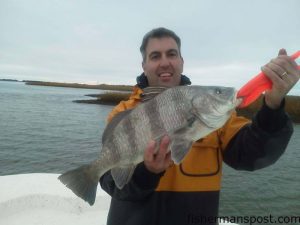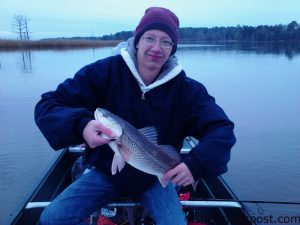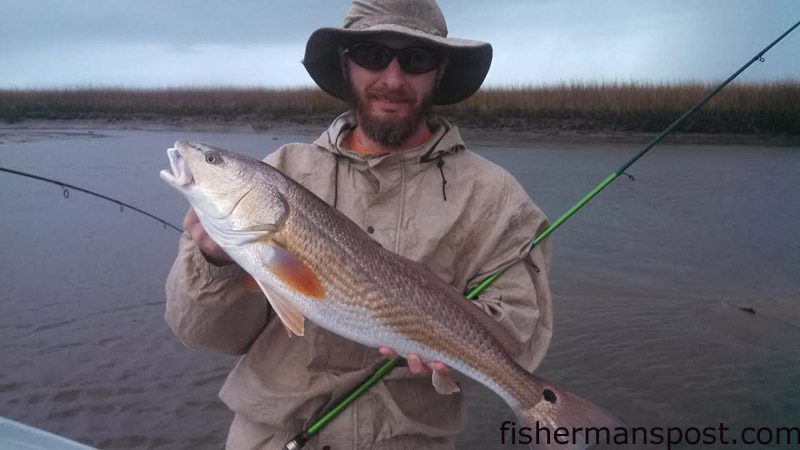Carolina Beach March 6, 2014

Frank Daly, of Raleigh, with a black drum that struck a shrimp on a jighead in off the lower Cape Fear River while he was fishing with Capt. Jeff Wolfe of Seahawk Inshore Charters.
Dennis, of Island Tackle and Hardware, reports that anglers have been seeing plenty of action offshore when the weather has calmed enough for a run to the break. Blackfin tuna and wahoo are feeding around local Gulf Stream spots like the Steeples and Same Ol’ Hole and are taking an interest in ballyhoo and skirted trolling lures.
Bottom fishing just inside the break has been producing fast action with large beeliners, black sea bass, triggerfish, and more. Multi-hook rigs baited with squid or cut baits are getting plenty of attention from the bottom feeders.
Inshore fishing has been slow with all the cold weather lately, but it should be coming around as the temperatures warm up and winter turns to spring. Sea mullet will be some of the first fish to arrive, and they should provide fast action for anglers fishing near the mouth of the Cape Fear River in the coming weeks. The smaller mullet are the first to arrive, but anglers typically see the largest fish of the year in spring and they should be right on the heels of the dinks. Fishing channel edges and flats with cut shrimp on double-hook rigs is the way to connect with the mullet.
Robert, of Carolina Explorer, reports that anglers have been connecting with red drum all winter long in the creeks and backwaters off the lower Cape Fear River. Most of the action has been in deeper holes adjacent to oyster rocks. Live minnows and Gulp baits pinned to jigheads are fooling the reds. A few black drum are feeding in the same areas and taking an interest in live and dead shrimp.

Jacob Cooper, of Burgaw, NC, with a 20″ red drum that bit a chunk of mullet while he was fishing the Brunswick River.
Some speckled trout are also feeding in the creeks and around oyster rocks, where anglers are fooling them with soft plastic baits. Anglers should remember that trout season is closed until June 15th, so it’s a catch-and-release fishery until then.
The trout and red action should get even better as winter turns to spring and the water temperatures rise, making the fish more active and spread out.
Anglers should also see sea mullet begin feeding along channel edges in the lower river over the coming weeks. Bottom rigs baited with shrimp, bloodworms, and other smelly offerings will tempt bites from the tasty mullet.
Jeff, of Seahawk Inshore Fishing Charters, reports that the red drum bite has been a bit slower this winter than in years past, but anglers are still catching double-digit numbers on many days. Some larger schools have been working the flats off the lower Cape Fear River, but it’s been tough to get them to bite on many days. Live mud minnows and live and dead shrimp have been the most effective baits, but anglers are hooking some on Gulp baits as well.
Speckled trout are feeding around structure and deeper water in the creeks off the river, and Gulp shrimp have been tempting them to bite.
Black drum are also looking for meals around structure like oysters and rocks in the same areas, and they’re taking an interest in cut shrimp.
As the water warms over the coming month, the schools of reds should begin feeding more actively and anglers should also see improved action with the trout and black drum.

Robbie with an over-slot red drum that bit a Gulp bait in a creek off the lower Cape Fear River while he was fishing with Capt. Robert Schoonmaker of Carolina Explorer Charters.
Sea mullet should start making an appearance in the lower river around the middle of the month, and anglers can fool the tasty panfish into biting bottom rigs baited with shrimp.
Jamie, of Seagate Charters, reports that anglers are seeing some solid striped bass action in the Cape Fear River, where soft plastic baits and diving plugs worked along shoreline structure and drop-offs are producing plenty of bites. A few red drum are mixed in.
Red and black drum are also feeding along docks inshore of Wrightsville and Carolina beaches. Cut shrimp are tough for both drum to turn down.
In addition, anglers are hooking some speckled trout around docks and in boat basins inshore, where soft and hard plastic baits are producing results.
Schools of red drum are feeding in the surf zone, too, and anglers running the beach on calm days can find the schools and cast soft plastics or metal lures to hook up.





